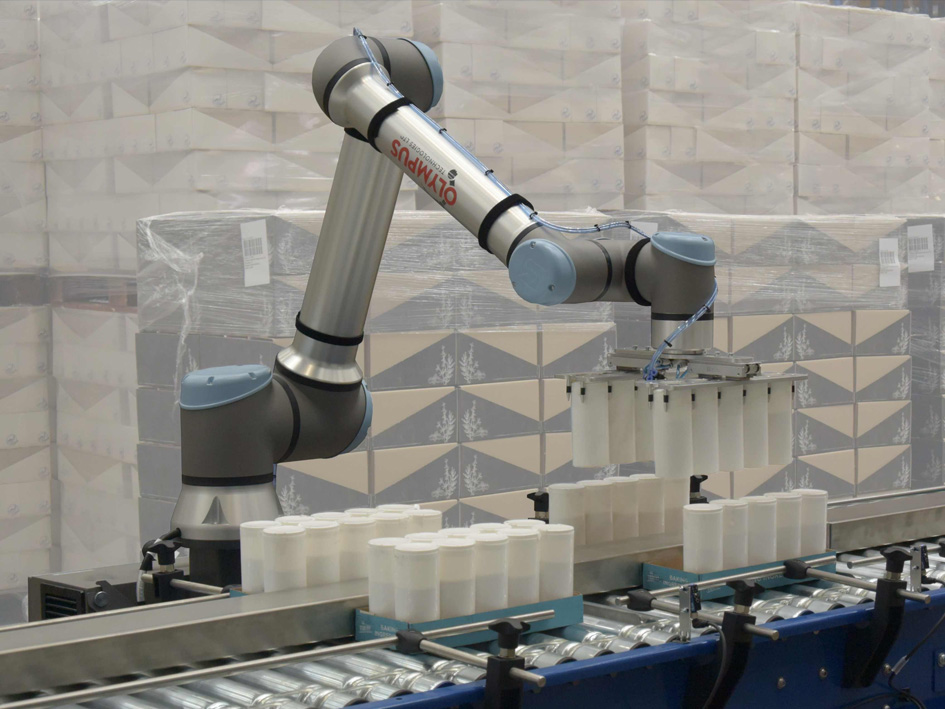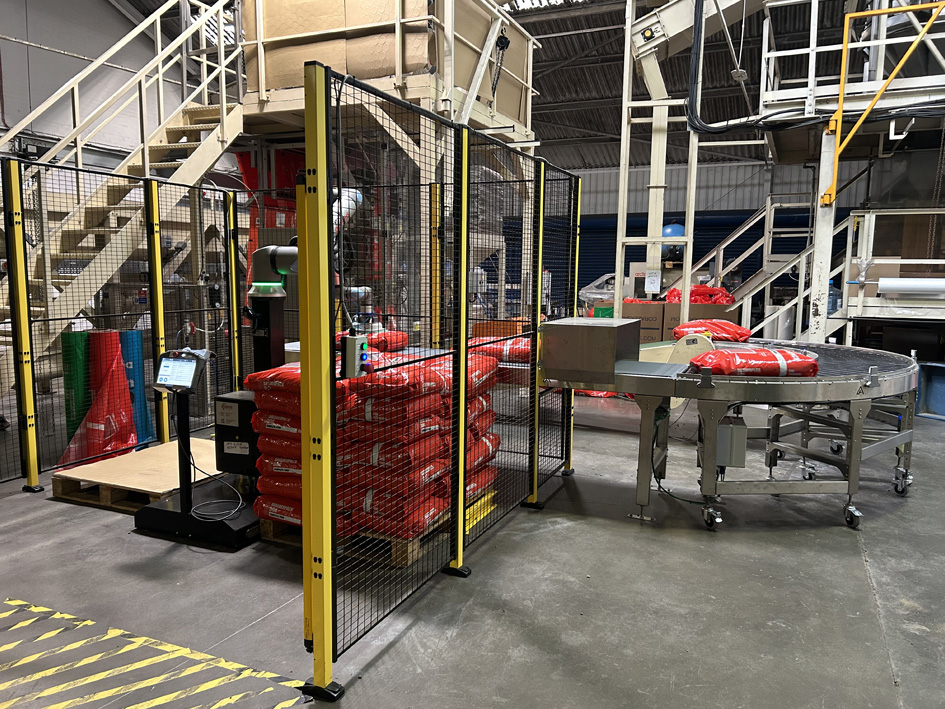Why OTIF Matters in Modern Manufacturing
OTIF (On Time In Full) measures a manufacturer’s ability to deliver complete orders on schedule. A consistently high OTIF score improves customer satisfaction, reduces penalties, and reflects strong operational efficiency.
Meeting OTIF targets depends on four factors: supply chain visibility, accurate inventory management, efficient production, and smart automation. Olympus Technologies’ cobots are designed to support all four, helping manufacturers across automotive, aerospace, and general industry improve OTIF performance with flexible, scalable automation.
Speak to Olympus about how our cobots help improve your OTIF performance.
Understanding OTIF Metrics
OTIF is made up of two key delivery measures:
- On Time Delivery (OTD): Was the shipment delivered by the promised date?
- In Full Delivery (IFD or Time In Full): Was the full order delivered correctly, without shortages or substitutions?
The OTIF performance score is calculated by multiplying OTD by IFD. For example, 95% OTD and 96% IFD results in 91.2% OTIF. Tracking these metrics helps companies identify gaps in planning, fulfilment, and logistics that affect delivery performance.
Benefits of Improving OTIF Performance
Boosting your OTIF score brings measurable benefits. Customers receive orders on time and in full, improving trust and reducing complaints. Internally, teams save time by avoiding rework, expedited shipping, and inventory errors.
Olympus cobots reduce production bottlenecks that delay deliveries. With faster cycle times and fewer manual errors, cobots help manufacturers meet OTIF requirements while reducing total supply chain costs.
Learn how Olympus’ cobot solutions improve efficiency across supply chains.
The Role of Supply Chain Visibility in OTIF
Supply chain visibility is essential to maintaining OTIF performance. Sharing real-time production, inventory, and logistics data helps planners adjust schedules before disruptions escalate.
Olympus cobots are designed for seamless integration with connected systems. This visibility supports faster responses, improved delivery timing, and greater control over OTIF metrics.
Inventory Management for OTIF Success
Effective inventory management ensures the right products and parts are available when needed. Barcode tracking, RFID, and automated stock monitoring help maintain optimal stock levels without increasing costs.
Cobots support this by maintaining steady, predictable production, reducing overages and shortages. By aligning output with demand, companies improve both On Time and Time In Full delivery.
Explore Olympus cobot integration for smarter inventory alignment.
Improving Time In Full (TIF) Delivery
Time In Full represents the accuracy and completeness of each order. Achieving high TIF requires stable processes, minimal handling errors, and reliable output.
Olympus cobots help by:
- Reducing manual errors in packing, welding, and assembly.
- Supporting capacity-based planning with predictable throughput.
- Maintaining consistent product quality, cutting rework and returns.
Practical Strategies to Improve OTIF
Manufacturers looking to improve OTIF can adopt the following high-impact, data-driven strategies:
1. Track and Refine OTIF KPIs
Measure OTD, IFD, and total OTIF by product, region, and customer. Use dashboards to highlight missed deliveries, short picks, and repeat issues. Share results across teams to drive ownership and improvement.
2. Lean Manufacturing Principles
Apply lean principles like Takt time, 5S, and visual management to eliminate waste. Cobots support this by standardising key operations and maintaining stable production flow that aligns with customer demand.
3. Cobot Automation in Production and Welding
Olympus cobots increase uptime, reduce cycle time, and deliver consistent quality. In welding and light assembly, cobots minimise delays that cause missed shipments, helping you stay on schedule and deliver in full.
4. Total Productive Maintenance (TPM)
Cobots are designed for low-maintenance, high-reliability operation. Combined with TPM practices, this reduces downtime and helps protect OTIF delivery commitments.
5. Supplier Collaboration
Use cobot-enabled production data to share accurate forecasts with suppliers. Collaborative planning reduces inbound delays, aligns delivery schedules, and helps meet customer expectations for both time and completeness.
Measuring and Tracking OTIF Performance
Integrate OTIF into regular operational reviews. Track OTD, IFD, and OTIF by week, by customer, or by product line. Complement this with other KPIs like lead time, first-pass yield, backorder rates, and fill rates.
With Olympus cobots driving production efficiency, it’s easier to maintain high OTIF scores across multiple product lines.
Supply Chain Optimisation for OTIF Success
Real OTIF improvement happens when production, inventory, and planning are aligned. Olympus cobots make this possible by increasing throughput, lowering errors, and supporting predictable workflows.
By connecting real-time data across systems, cobot-based production helps you identify issues early, reduce costs, and deliver reliably - every time.
Contact Olympus today to discover how cobots support OTIF success across your operations.
Conclusion: Build a Reliable and Competitive Supply Chain with Cobots
Delivering on time and in full is no longer optional. Manufacturers that prioritise OTIF are better positioned to grow, reduce costs, and exceed customer expectations.
Olympus cobots provide the flexibility and efficiency needed to meet OTIF goals without sacrificing quality. Whether in welding, material handling, or assembly, our cobots help you optimise production and stay compliant with delivery standards.
Book a consultation to improve your OTIF performance with Olympus Technologies cobot automation.
FAQs
How do cobots help improve OTIF performance?
Cobots from Olympus support consistent output, reduce manual errors, and stabilise production flow. This helps you meet customer delivery deadlines and achieve high OTIF scores across product lines.
Can cobots reduce lead times and improve Time In Full delivery?
Yes. Cobots reduce variability in output, improving scheduling and supporting Time In Full accuracy. With fewer mistakes and delays, you reduce rework and avoid partial shipments.
Are cobots suitable for small- to mid-volume manufacturers aiming to improve OTIF?
Absolutely. Olympus cobots are scalable and flexible, making them ideal for varied manufacturing setups. They help businesses deliver efficiently - even when demand fluctuates.
How does real-time data from cobots support OTIF?
Our cobots integrate with real-time dashboards and MES systems. This allows teams to monitor performance, respond to disruptions, and make data-driven decisions that support OTIF delivery.














